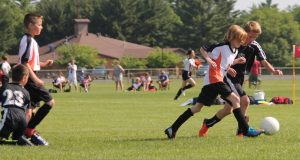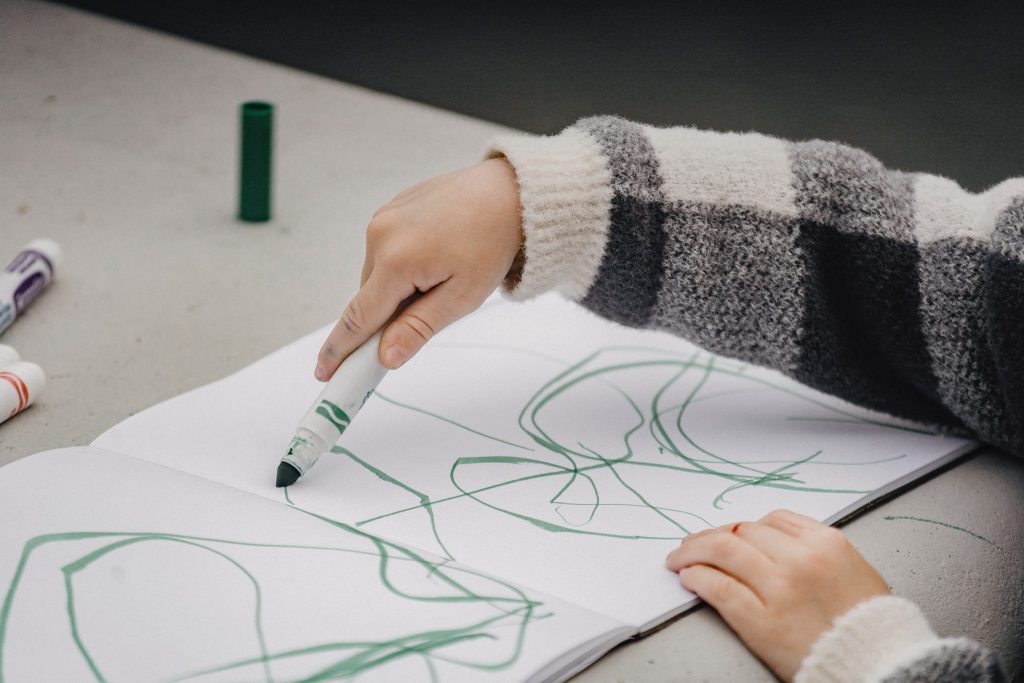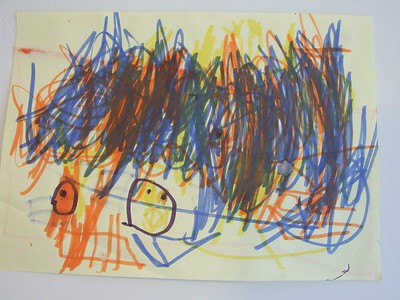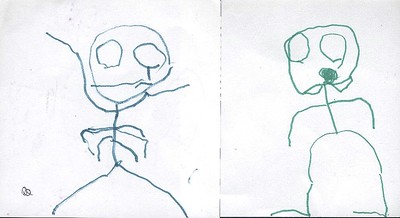Chapter Eight: Early Childhood Development
Physical Development in Early Childhood
Growth in Height and Weight
Children continue to grow greatly during early childhood. The average child grows 2 ½ inches and gains between 5 and 7 pounds a year. Each year as they grow older, their increases in height and weight decrease. Growth patterns are affected by genetics, growth hormones and environmental factors. Some reasons for unusually small children are genetic problems, prenatal problems, physical problems in early childhood and emotional problems. Deprivation dwarfism is a condition in which children who are deprived of attention do not grow at a normal rate. This deprivation affects the release of hormones by the pituitary gland.
Girls are slightly smaller and lighter than boys during the preschool years, and most children have lost their “top heavy” look. Boys gain muscle and girls gain fatty tissue during this time. Children are fascinated by their bodies. They are constantly asking questions about their bodies and are beginning to understand the physical differences between boys and girls. Two developmentally appropriate books to share with children are “The Body Good” by Claire Raynor and “Blood and Guts” by Linda Allison.
Brain Development
The brain and the head experience the fastest growth in the body. It is 75% of adult size by age 3 and 90% of adult size by age 5. It is interesting to note that at age five a child’s body is only 1/3 of adult size. The top parts of the head, the eyes and the brain grow faster than the jaw. Nerve endings continue to grow into adolescence. Myelination refers to the process by which nerve cells are insulated. Myenilation makes information process more quickly. It occurs in the areas of the brain related to hand/eye coordination at 4 years old and in the areas related to attention in middle childhood. It is interesting to think about the pressure we put on children to spend large amounts of time sitting and focusing in preschool when their brains need more active learning to develop.
There are also structural changes in the brain. The brain undergoes dramatic anatomical changes between ages 3 and 15. Some areas almost double in size, and the purge of unneeded cells follows up to the age of 4. Frontal lobe growth occurs between 3 and 6 years of age, and temporal and parietal lobes from age 6 through puberty (Berk, 2017; Hyson, 2014).
Signs of Vision Problems
It is important for children to have regular vision screening before age 3. Treatment before age 6 can prevent vision loss. It can sometimes be difficult to discern if a child is having vision problems. Some signs to look for are tilting of the head, squinting, irritability when asked to complete tasks that require long distance vision, rubbing the eyes, shutting and covering one eye, excessive blinking, and headaches. Two eye conditions that many children suffer are functional amblyopia and strabismus. Functional amblyopia, also called lazy eye, is an eye defect that occurs when one eye is not used as much as the other eye to avoid the discomfort of double vision. It is caused by imbalanced eye muscles. Strabismus is misalignment of the eyes (CDC, 2022).
Gross Motor Skills
 Preschoolers have the highest activity level of any age in the life span. They need daily exercise, and good programs with creativity and free movement. Exercise increases physical and visual awareness. Children’s gross motor skills develop when they use the large muscles of their body. At age 3, children enjoy simple movements such as hopping, jumping, running back and forth, throwing a ball underhand, catching a large ball and catching a bounced ball. At age 4, children become more adventurous and love to climb. They can kick a ball towards a target, bounce a ball under control, hop on one foot four times and come down stairs with one foot on each step. At age 5, children run hard, enjoy races, kick a rolling ball, skip using alternating feet, roller skate, jump rope, ride a two-wheeled bike with training wheels and are adventurous and try hair-raising stunts in climbing. Some gross motor ideas to incorporate into a preschool classroom are:
Preschoolers have the highest activity level of any age in the life span. They need daily exercise, and good programs with creativity and free movement. Exercise increases physical and visual awareness. Children’s gross motor skills develop when they use the large muscles of their body. At age 3, children enjoy simple movements such as hopping, jumping, running back and forth, throwing a ball underhand, catching a large ball and catching a bounced ball. At age 4, children become more adventurous and love to climb. They can kick a ball towards a target, bounce a ball under control, hop on one foot four times and come down stairs with one foot on each step. At age 5, children run hard, enjoy races, kick a rolling ball, skip using alternating feet, roller skate, jump rope, ride a two-wheeled bike with training wheels and are adventurous and try hair-raising stunts in climbing. Some gross motor ideas to incorporate into a preschool classroom are:
- Beam Walking
- Daily Fitness Activities
- Creative Movement With Music
- Moving To A Steady Beat
- Including Language Activities (over, under, around)
- Including Perceptual Activities (copying teacher’s movements)
Remember that children are not able to sit still! (Hyson, 2014)

Fine Motor Skills
Fine motor skills are subtler movement skills in children’s hands and fingers. At age 3, children are still clumsy at picking things up with their thumb and forefinger. They have difficulty placing pieces in a puzzle but are adept at building block towers. At age 4, their coordination has improved and is more precise. They are much better at puzzles. At age 5, the hand, arm, and body all move together well. Children want to build a more detailed block structure. Hand strengthening activities are important during this time. Finger painting, squeezing stress balls, tearing paper, manipulating windup toys and spray bottles can all strengthen children’s hands, which will lead to increased fine motor skills for when children are learning to write (Gestwicki, 2017; Shaffer, 2000).
Young Children’s Artistic Drawings
Art provides a hands-on approach to problem solving skills; it reinforces ideas of scale, space, motion and distance. Child art reflects inventive problem solving. Developmental changes depend on talent, motivation, familial support and cultural values. It flourishes in sociocultural contexts where tools are available and art activity is valued.
Rhoda Kellogg is a preschool teacher who has observed and guided young children’s artistic efforts for many years. She has collected over 2,000 samples of drawings produced by preschool children. She documented that children’s art is ordered, structured and meaningful. She outlines five stages of artistic development:





(Berk, 2017; Santrock, 2013; Jensen & Arnett, 2019).
Handedness
People argue about whether handedness is determined at birth. Some believe it is genetically inherited. Others believe it develops in early childhood. Right-handedness is dominant in all cultures. Hand preference may occur in the womb. Many preschoolers use both hands before preference develops later.
Approximately 95% of right-handed individuals process speech primarily in the left hemisphere. Left-handed individuals show more variation in processing and are more likely to have reading problems.
Left-handers are more common among mathematicians, musicians, architects and artists (Berk, 2017; Santrock, 2013; Jensen & Arnett, 2019).
Sleep and Sleep Problems
By preschool, most young children sleep through the night. Many use transitional objects: stuffed animals, blankets, etc. to help them sleep independently. Sometimes sleep can be interrupted by nightmares, night terrors and somnambulism. Nightmares are frightening dreams that usually wake the sleeper. Night terrors are characterized by sudden arousal and are extremely intense. Somnambulism is sleep walking (Berk, 2017; Santrock, 2013; Jensen & Arnett, 2019).
Nutrition
Proper nutrition is extremely important in early childhood. Energy/calorie needs increase with age. Diets should be well balanced. Young children should avoid excessive fast food, fat and sugar. This can be difficult as children grow older and are exposed to different types of food. Children’s diets worsen with age. Parents should be persistent in exposing children to the right foods. They should avoid giving children sweets at snack times and set limits on certain foods. Childhood obesity is on the rise. The average American child consumes almost 2 pounds of sugar a week! Be aware of hidden sugar in juices, cereals, granola bars, ketchup and crackers. Lifelong eating habits are determined in early childhood.
Sweets, snacks and fussy eaters: Many eating problems carry over from toddler years. It is important to allow a child to eat in any order/combination, let the meal end when the child has had enough, keep mealtimes enjoyable, and not use food as a reward or punishment.
Obesity in children: The percentage of obese children is increasing. It is important to encourage children to make independent and better choices. Childhood obesity affects health problems. Obesity is linked to poor self-esteem. Caregivers should center life around activities, not meals, and keep children active.
Malnutrition is linked to many aspects of development: iron deficiency anemia, cognitive deficits, aggressive and hyperactive behavior. Underfed children tend to receive less supervision, stimulation and education.
How children eat at different ages
- 3 year olds
- o Appetite good, prefer small servings
- o Eat almost everything except cooked vegetables.
- o Feed themselves independently
- o Dawdle over food
- o Can pour milk and juice
- o Begin to drink a lot of milk
- 4 year olds
- o Appetite changes from good to fair
- o May refuse to eat certain foods
- o Use all eating utensils
- o Talking dominates eating
- o Like to help in the preparation of a meal
- 5 year olds
- o Usually eat well, but not at every meal
- o Like familiar foods
- o Are influenced by the dislikes of other family members
- o Like to make their own breakfast
Accident Prevention
Accidents are the leading cause of death in children ages 1 through 4. Most accidents occur in the bathtub or in the car. Many injuries can be prevented. Caregivers should always use car seats and lock up guns. They should childproof home and playground and make sure playground equipment is well constructed (CDC, 2022).
Media Attributions
- Soccer © Image by Josh Dick from Pixabay is licensed under a CC0 (Creative Commons Zero) license
- Girl finger painting © Pixabay is licensed under a CC BY (Attribution) license
- Child drawing with a marker © Allan Mas via. Pexels is licensed under a CC0 (Creative Commons Zero) license
- Drawing scribbles © Flickr is licensed under a CC BY-SA (Attribution ShareAlike) license
- Drawing shapes © Flickr is licensed under a CC BY (Attribution) license
- Drawing stick figures © Flickr is licensed under a CC BY (Attribution) license
- Drawing chalk © Flickr is licensed under a CC BY (Attribution) license

